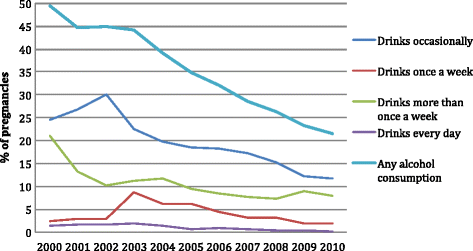Alcohol consumption among pregnant women in Northern Tanzania 2000-2010: a registry-based study
- PMID: 26337194
- PMCID: PMC4559883
- DOI: 10.1186/s12884-015-0630-0
Alcohol consumption among pregnant women in Northern Tanzania 2000-2010: a registry-based study
Abstract
Background: Alcohol can be harmful to the development of the foetus. In most developed countries, pregnant women are recommended to abstain from alcohol, however in developing countries, women are less likely to receive these recommendations. With respect to pregnant women in Northern Tanzania, this study aims to 1) describe time trends in level of alcohol consumption, 2) assess socio-demographic predictors of alcohol consumption, and 3) describe associations between alcohol consumption and health-related maternal and foetal outcomes.
Methods: Data related to 34,090 births between 2000 and 2010 was obtained from the Medical Birth Registry at Kilimanjaro Christian Medical Centre (KCMC) in Moshi, Tanzania and analysed. Poisson regression analysis was used to assess associations between potential risk factors and alcohol consumption, and between alcohol consumption during pregnancy and maternal and foetal health outcomes.
Results: From 2000 to 2010, the proportion of women reporting alcohol consumption during pregnancy decreased from 49.5 to 21.5%. The socio-demographic predictors most strongly related to alcohol consumption were religion (Catholics 53.6%, Protestants 25.9%, Muslims 14.8%) and tribe (Chaggas 45.2%, Pares 17.3%, Maasais 6.6%). Pregnant women consuming alcohol were more likely to be older, taller, and have higher pre-pregnancy body mass index, and were less likely to present with anaemia (Hb < 11.0 g/dl) at last antenatal care (ANC) visit/at admission; adjusted relative risk (ARR) 0.84 (95% confidence interval 0.79-0.90) for alcohol consumption vs. abstinence. Maternal alcohol consumption during pregnancy was associated with a decreased risk of being small for gestational age (ARR 0.87 (0.80-0.94) and a decreased risk of gestational age less than 37 weeks (ARR 0.89 (0.81-0.99).
Conclusions: The proportion of pregnant women reporting alcohol consumption decreased by 56.5% from 2000 to 2010. Alcohol intake was strongly associated with socio-demographic factors. The association between alcohol intake and favourable perinatal outcomes remained significant after maternal factors were adjusted for. Information on diet, lifestyle factors and maternal health might give further insight into this unexpected observation. The proportion of pregnant women consuming alcohol in Northern Tanzania is high, and greater awareness of health outcomes associated with alcohol consumption is advised.
Figures
Similar articles
-
Pregnancy intervals: their determinants and foetal outcome at the KCMC, Moshi, Tanzania.East Afr Med J. 1993 Sep;70(9):544-50. East Afr Med J. 1993. PMID: 8181433
-
Frequency, risk factors and feto-maternal outcomes of abruptio placentae in Northern Tanzania: a registry-based retrospective cohort study.BMC Pregnancy Childbirth. 2015 Oct 7;15:242. doi: 10.1186/s12884-015-0678-x. BMC Pregnancy Childbirth. 2015. PMID: 26446879 Free PMC article.
-
Antenatal depression is associated with pregnancy-related anxiety, partner relations, and wealth in women in Northern Tanzania: a cross-sectional study.BMC Womens Health. 2015 Sep 2;15:68. doi: 10.1186/s12905-015-0225-y. BMC Womens Health. 2015. PMID: 26329331 Free PMC article.
-
Preventing alcohol-exposed pregnancies.J Am Board Fam Med. 2006 Sep-Oct;19(5):494-505. doi: 10.3122/jabfm.19.5.494. J Am Board Fam Med. 2006. PMID: 16951299 Review.
-
A review of policies on alcohol use during pregnancy in Australia and other English-speaking countries, 2006.Med J Aust. 2007 May 7;186(9):466-71. doi: 10.5694/j.1326-5377.2007.tb00999.x. Med J Aust. 2007. PMID: 17484709 Review.
Cited by
-
Alcohol use during pregnancy and associated factors among pregnant women in Sub-Saharan Africa: further analysis of the recent demographic and health survey data.BMC Pregnancy Childbirth. 2022 Apr 26;22(1):361. doi: 10.1186/s12884-022-04694-z. BMC Pregnancy Childbirth. 2022. PMID: 35473590 Free PMC article.
-
Alcohol consumption and associated factors among pregnant women attending antenatal care at governmental hospitals in Harari regional state, Eastern, Ethiopia.Subst Abuse Treat Prev Policy. 2023 Oct 31;18(1):61. doi: 10.1186/s13011-023-00567-6. Subst Abuse Treat Prev Policy. 2023. PMID: 37904208 Free PMC article.
-
Maternal alcohol consumption during pregnancy and associated factors among pregnant women in Tanzania: evidence from the 2022 Tanzania Demographic and Health Survey.BMC Pregnancy Childbirth. 2025 Mar 27;25(1):359. doi: 10.1186/s12884-025-07149-3. BMC Pregnancy Childbirth. 2025. PMID: 40148758 Free PMC article.
-
Magnitude and risk factors of khat, alcohol and cigarettes use among pregnant women in Africa: a systematic review and meta-analysis.BMC Pregnancy Childbirth. 2024 Nov 27;24(1):795. doi: 10.1186/s12884-024-06999-7. BMC Pregnancy Childbirth. 2024. PMID: 39604865 Free PMC article.
-
The burden of generational harm due to alcohol use in Tanzania: A mixed method study of pregnant women.PLOS Glob Public Health. 2024 Dec 30;4(12):e0003681. doi: 10.1371/journal.pgph.0003681. eCollection 2024. PLOS Glob Public Health. 2024. PMID: 39775343 Free PMC article.
References
-
- Global Status Report on Alcohol and Health. Geneva, Switzerland: World Health Organization; 2011.
-
- Korkman M, Autti-Rämö I, Koivulehto H, Granström ML. Neuropsychological effects at early school age of fetal alcohol exposure of varying duration. Child Neuropsychol. 1998;4:199–212. doi: 10.1076/chin.4.3.199.3171. - DOI
-
- U.S. Surgeon General releases advisory on alcohol use in pregnancy [https://wayback.archive-it.org/3926/20140421162517/http://www.surgeongen...]Accessed 24 August 2015.
Publication types
MeSH terms
LinkOut - more resources
Full Text Sources
Other Literature Sources
Medical


